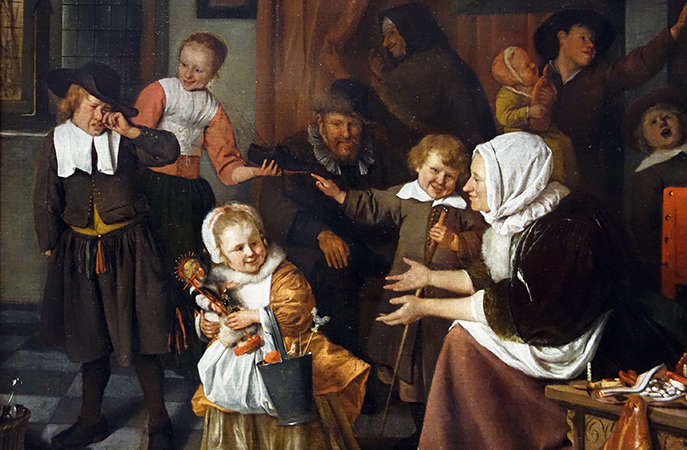Jan Steen, Feast of St. Nicholas
A holiday for children

In this delightful scene, Jan Steen [pronounced Stain] beautifully captures the joys of a family gathering together in their home to celebrate the Feast of St. Nicholas, still one of the most important holidays on the Dutch calendar. The holiday falls on December 6th and is especially devoted to children. In the Netherlands, on the night before the feast, St. Nicholas travels on horseback over rooftops accompanied by his helper, Zwarte Piet (“Black Peter”), whose name comes from his being covered in soot from the chimneys used to access Dutch homes. Children place their shoes on the hearth and hope to find them the next morning filled with presents and other delectable treats. Families sing songs in honor of the saint and share an abundance of candies, specially baked breads, and sweet biscuits. It is a day full of fun and surprises and even a bit of mischief.
A master visual storyteller, Steen incorporates many of these traditions in his painting while also expertly representing the actions and expressions of the children in this middle class family as they react to the morning’s events. A smiling mother reaches out to her daughter who clings possessively to the gift she has received: a doll clad in white fur with a halo and holding a cross-shaped staff, which represents St. John the Baptist. On the child’s arm, a pail hangs full of goodies including an orange, a gingerbread figure, and a sugar candy chicken on a stick.

The girl’s brother, behind her to the right, also seems quite pleased with his gift, a kolf club and ball. A game analogous to modern hockey, kolf was played on frozen canals in the winter and on level land in summer. Players both young and old enjoyed propelling a small wooden ball toward a goal post using sticks that were curved at the end like the one we see here.

The boy laughs and points to a shoe held by a young maidservant. The shoe contains birch switches that were used to punish naughty children. Clearly, a tearful boy, to the maidservant’s right, received the shoe as a not-so-desirable gift for his poor behavior.

His grandmother, however, beckons him toward the bed in the back of the room, where it appears that she has discovered a better gift hidden behind the bed curtains. On the right side of the scene, three additional children gaze with wide-eyed amazement toward the chimney through which their presents were delivered. An older brother holds up a toddler for a better view. The toddler hugs a gingerbread version of St. Nicholas, a reminder of who is being honored on this joyous occasion.

In the foreground of this domestic interior, Steen tempts us with an assortment of treats piled high in a woven basket and strewn across the seat of an ornately carved chair. Here we see apples, nuts, sugared candies, waffles and other baked delights of various shapes and sizes. Particularly impressive is the large, richly decorated diamond-shaped loaf that leans against the chair. This sweet white bread, called a duivekater, was traditionally enjoyed at the Feast of St. Nicholas, as well as at Christmas, and on the Dutch New Year.[1]
- Dr. Wendy Schaller, "Jan Steen, Feast of St. Nicholas," in Smarthistory, August 8, 2015, accessed March 21, 2023, https://smarthistory.org/jan-steen-feast-of-st-nicholas/ ↵

